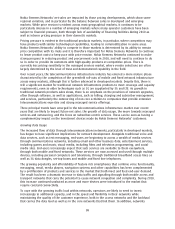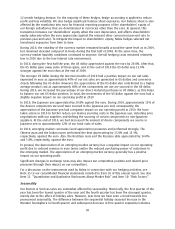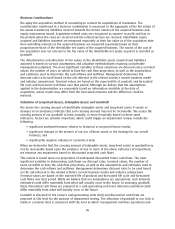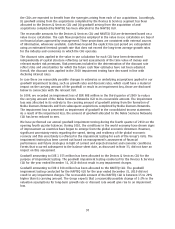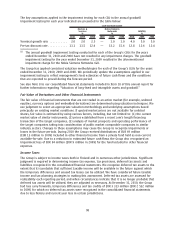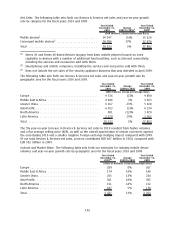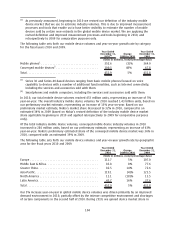Nokia 2010 Annual Report Download - page 95
Download and view the complete annual report
Please find page 95 of the 2010 Nokia annual report below. You can navigate through the pages in the report by either clicking on the pages listed below, or by using the keyword search tool below to find specific information within the annual report.Allowances for Doubtful Accounts
We maintain allowances for doubtful accounts for estimated losses resulting from the subsequent
inability of our customers to make required payments. If the financial conditions of our customers
were to deteriorate, resulting in an impairment of their ability to make payments, additional
allowances may be required in future periods. Management specifically analyzes accounts receivables
and historical bad debt, customer concentrations, customer creditworthiness, current economic trends
and changes in our customer payment terms when evaluating the adequacy of the allowance for
doubtful accounts. Based on these estimates and assumptions the allowance for doubtful accounts
was EUR 363 million at the end of 2010 (EUR 391 million at the end of 2009).
Inventoryrelated Allowances
We periodically review our inventory for excess, obsolescence and declines in market value below cost
and record an allowance against the inventory balance for any such declines. These reviews require
management to estimate future demand for our products. Possible changes in these estimates could
result in revisions to the valuation of inventory in future periods. Based on these estimates and
assumptions the allowance for excess and obsolete inventory was EUR 301 million at the end of 2010
(EUR 361 million at the end of 2009). The financial impact of the assumptions regarding this
allowance affects mainly the cost of sales of the Devices & Services and Nokia Siemens Networks
segments.
Warranty Provisions
We provide for the estimated cost of product warranties at the time revenue is recognized. Our
products are covered by product warranty plans of varying periods, depending on local practices and
regulations. While we engage in extensive product quality programs and processes, including actively
monitoring and evaluating the quality of our component suppliers, our warranty obligations are
affected by actual product failure rates (field failure rates) and by material usage and service delivery
costs incurred in correcting a product failure. Our warranty provision is established based upon our
best estimates of the amounts necessary to settle future and existing claims on products sold as of
the balance sheet date. As we continuously introduce new products which incorporate complex
technology, and as local laws, regulations and practices may change, it will be increasingly difficult to
anticipate our failure rates, the length of warranty periods and repair costs. While we believe that our
warranty provisions are adequate and that the judgments applied are appropriate, the ultimate cost
of product warranty could differ materially from our estimates. When the actual cost of quality of our
products is lower than we originally anticipated, we release an appropriate proportion of the
provision, and if the cost of quality is higher than anticipated, we increase the provision. Based on
these estimates and assumptions the warranty provision was EUR 928 million at the end of 2010
(EUR 971 million at the end of 2009). The financial impact of the assumptions regarding this
provision mainly affects the cost of sales of our Devices & Services segment.
Provision for Intellectual Property Rights, or IPR, Infringements
We provide for the estimated future settlements related to asserted and unasserted past alleged IPR
infringements based on the probable outcome of each potential infringement.
Our products include increasingly complex technologies involving numerous patented and other
proprietary technologies. Although we proactively try to ensure that we are aware of any patents and
other intellectual property rights related to our products under development and thereby avoid
inadvertent infringement of proprietary technologies, the nature of our business is such that patent
and other intellectual property right infringements may and do occur. Through contact with parties
claiming infringement of their patented or otherwise exclusive technology, or through our own
monitoring of developments in patent and other intellectual property right cases involving our
competitors, we identify potential IPR infringements.
94




